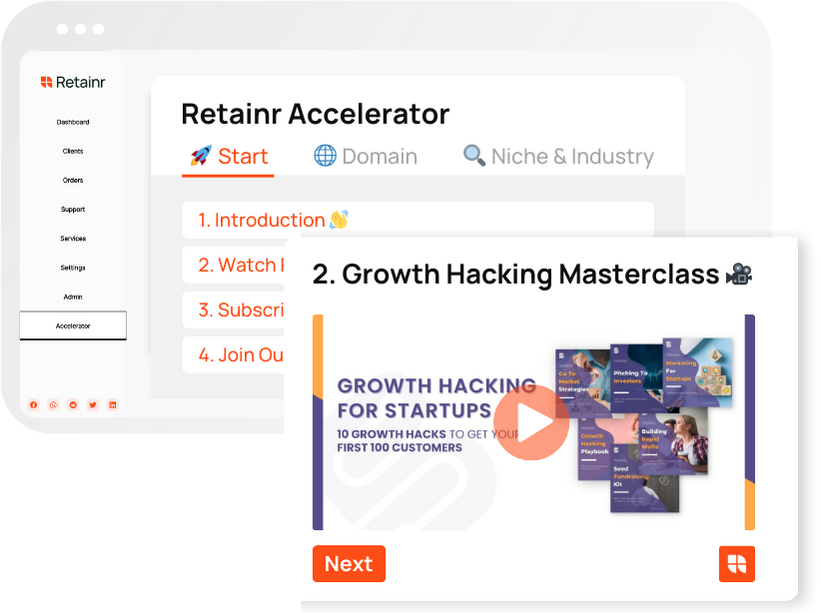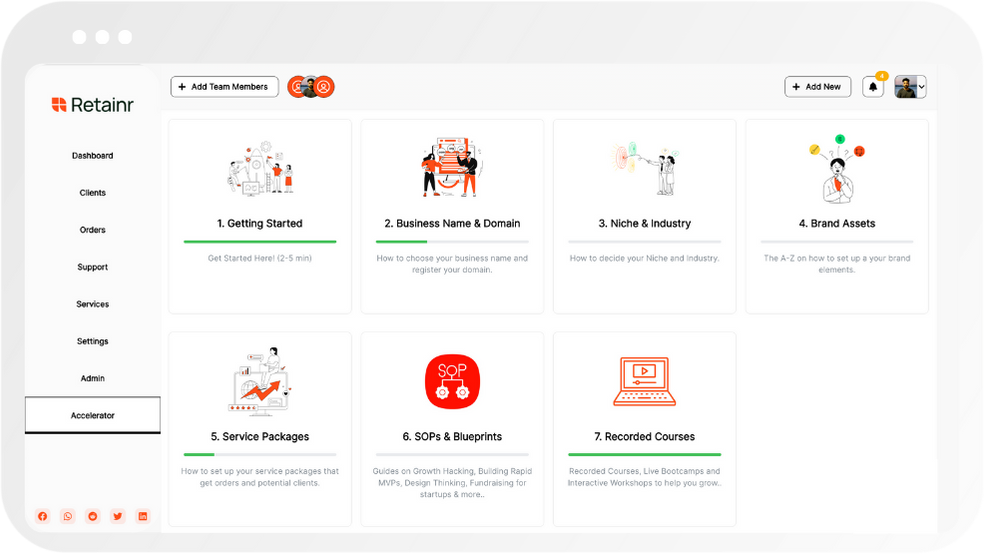
8 Step guide for Customer-centric business models
Build with Retainr
Sell your products and services, manage clients, orders, payments, automate your client onboarding and management with your own branded web application.
Get Started1. What is a customer-centric business model?
Understanding the Customer-Centric Business Model
A customer-centric business model is a strategic approach that places the customer at the core of a company's operations and processes. Instead of focusing mainly on sales or products, this type of approach prioritizes the needs, preferences, and overall experience of the customer above all else. The main goal is to foster customer loyalty through superior service and offerings that respond to their unique demands. A customer-centric company hopes that this customer satisfaction will lead to higher retention rates, and potentially, increased profitability.
How the Model Works
The customer-centric model operates on a few key principles. First, the company must truly understand its customers. This involves comprehensive market research, to deeply understand client needs, preferences, desires, and behaviors. Secondly, the customer-centered company commits to fostering relationships with their clients, often building long-term connections rather than seeking one-time transactions. Lastly, such companies recognize that each customer is unique and therefore personalization is key.
- Understanding the customer: through market research, surveys, and consumer analysis.
- Building relationships: by providing attentive support, showing customer appreciation, and creating loyalty programs.
- Personalizing experiences: with personalized messages, recommendations, and offerings based on client data and analytics.
Examples of Customer-Centered Companies
| Company | Customer-Centric Strategy |
|---|---|
| Amazon | Amazon utilizes advanced algorithms to offer highly personalized shopping experiences. It also has a highly responsive customer service. |
| Zappos | Zappos' legendary customer service is the cornerstone of their customer-centric approach, including a 365-day return policy. |
Other examples may include companies such as Apple, which focuses on user-friendly product designs, and Google, with its devotion to user experience.
2. What are the 8 steps involved in implementing a customer-centric business model?
Understanding the 8-step Process
In developing a sustainable customer-centric approach for a business, there are eight crucial steps that any business must follow. These steps ensure that the strategy applied is effective and will create a positive impact on customer experience, thus boosting the efficiency of the business.
Here is the detailed breakdown of these eight steps in implementing a customer-centric business model:
- Customer Discovery: Prioritize understanding your customer needs and preferences with the help of thorough market research.
- Segmentation: Divide your customers into various groups based on their unique characteristics and behaviors.
- Targeting: Choose the segments you want to focus on based on your business potentials and available resources.
- Positioning: Develop a unique selling proposition that makes your products or services stand out from the competition.
- Strategy Development: Develop a customer-centric strategy that addresses the needs and expectations of your customers.
- Implementation: Put the developed strategy into practice and ensure every aspect of your business aligns with it.
- Monitoring: Keep track of the performance of your strategy and make necessary adjustments when required.
- Continuous Improvement: Always look for ways to improve your strategy in response to changes in customer needs and market trends.
Detailing the 8 Steps using a Table
The table below gives an expanded view of what these steps entail and their impact on creating a customer-centric business model:
| Step | Description | Impact on Customer-Centric Model |
|---|---|---|
| Customer Discovery | Gather information about customer needs and preferences. | Helps to tailor products and services to suit customer needs. |
| Segmentation | Divide customers based on their unique characteristics and behaviors. | Ensures focused and effective strategies for each customer group. |
3. How does a customer-centric business model enhance a company's performance?
Benefits of a Customer-Centric Business Model
A customer-centric business model enhances a company's performance in several key areas. Here they are:
- Increased Customer Loyalty: When customers feel valued, they are more likely to remain loyal. This means more repeat business and a steady revenue stream for the company.
- Improved Customer Satisfaction: A customer-centric business model often includes an increased focus on customer service. This can lead to higher customer satisfaction rates.
- Enhanced Reputation: Companies with a customer-centric focus often enjoy a better reputation. This can lead to more business through referrals and word-of-mouth.
In the table below, we have a detailed comparison between a regular company and a customer-centric company.
| Indices | Regular Company | Customer-Centric Company |
|---|---|---|
| Focus | Product/Service | Customer Needs |
| Customer Loyalty | Low-Medium | High |
| Customer Satisfaction | Variable | High and Consistent |
| Company Reputation | Variable | Strong and Positive |
Grasping a customer-centric approach leads a business to significant growth and profitability. When a company consistently puts its customers' needs first, it frequently results in better business performance. After all, happy customers are the best brand ambassadors!
4. What is the role of customer feedback in a customer-centric business model?
The Importance of Customer Feedback
Customer feedback plays a pivotal role in a customer-centric business model. It serves as a crucial compass to guide the strategic direction of a business. Listening to customers helps businesses refine their products, services, and overall customer experience to align with what customers actually want and value.
- Improving Products and Services: Feedback from customers often provides direct insights into how businesses can enhance their offerings. Customers are the end-users of these products and services, hence their input is invaluable.
- Identifying and Solving Problems: Sometimes, businesses may not be aware of an existing problem until it's pointed out by customers. Feedback can shed light on these issues, allowing businesses to resolve them promptly.
- Understanding Customer Needs and Preferences: Customer feedback provides crucial information about what customers value most. This assists companies in creating customer-centric marketing strategies, as well as enhancing their offerings to match their customers' needs.
Analysing Customer Feedback Data
Once obtained, customer feedback data needs to be analysed effectively to uncover actionable insights. This analysis helps companies discern patterns, trends, and areas for improvement in customer sentiment and satisfaction. Here is a simple table illustrating how you might categorize and interpret collected customer feedback data.
| Feedback Type | Action Required |
|---|---|
| Product Feature Requests | Consider potential for product updates or new features |
| Negative Reviews or Complaints | Investigate issue, resolve promptly, and ensure customer satisfaction |
| Positive Reviews | Highlight strengths and leverage for promotional purposes |
Implementing Changes Based on Feedback
Addressing and acting upon customer feedback is the final and most crucial step in leveraging customer feedback for a customer-centric business model. Acting on the received feedback shows customers that their opinions are valued, which can significantly enhance their loyalty and satisfaction.
5. How can a company transition from a product-centric to a customer-centric approach?
Steps to Transition from Product-centric to Customer-centric Approach
Successfully transitioning from a product-centric to a customer-centric approach requires a strategic plan that fosters a customer-orientation in both company culture and operations. Below are some key steps to guide this shift:
- Create a Customer-Centric Vision: Define what customer-centricity means for your business. It could be providing exceptional customer service, tailoring products or services to customer needs, or enhancing user experience.
- Develop Customer-Centric Goals: Establish measurable objectives that emphasize customer satisfaction and loyalty. Goals can range from improving customer retention rates, reducing customer churn, to boosting customer lifetime value.
- Empower Employees: Train employees to understand and embrace the new approach. Leaders should show empathy, and encourage workers to think from the customer's perspective.
- Use Customer Feedback: Utilize customer feedback systems like surveys, social media, and review platforms to understand customer needs, preferences, and pain points.
- Implement Customer-Centric Processes: Customers' needs should be the center of business processes. This may entail changes in product development, marketing, sales, or other operations to better cater to customer requirements.
Significant Variables in the Transition Process
As part of the transition process, there are several important variables to consider, which can all impact the success of your customer-centric transformation. The following table provides a snapshot:
| Variables | Description |
|---|---|
| Company Culture | A culture that values customer satisfaction over product numbers will naturally foster a customer-centric environment. |
| Leadership Support | Leadership must support the transition by providing necessary resources, encouraging customer-focused behavior, and leading by example. |
| Customer Understanding | Deeply understanding customer needs, desires, and opinions through market research, customer feedback, and data analysis are keys to customer-centricity. |
Continuous Improvement and Evaluation
Once the transition to a customer-centric approach is underway, continuous improvement and evaluation are fundamental. Implement ways to measure the success of the transition, such as customer satisfaction scores or Net Promoter Score (NPS). Keep an open dialogue with your customers, regularly seeking their feedback to identify areas of improvement. By consistently evaluating your efforts, you can make necessary adjustments to refine your strategies and further augment your customer-centric culture.
6. What are some examples of successful customer-centric business models?
Global Companies and their Customer-Centric Models
In order to fully comprehend what a customer-centric model looks like, it is important to consider some successful examples. Renowned companies worldwide such as Amazon, Southwest Airlines, and Starbucks have been consistently praised for their customer-centric approaches. These companies have chosen to invest in their customer experience, leading to increased loyalty, satisfaction, and profitability.
| Company | Key Customer-Centric Strategies |
|---|---|
| Amazon | Personalized shopping experience, instant customer support, easy and flexible return policy. |
| Southwest Airlines | Passenger-focused services, no hidden fees, efficient complaint handling system. |
| Starbucks | Reward and loyalty program, personalized offers, mobile order and pay system. |
Startup Businesses Adopting Customer-Centric Models
On the other hand, there are also many startup companies that have successfully adopted a customer-centric business model from the get-go. For instance, Warby Parker, Glossier, and The Honest Company are a few such startups that have reimagined traditional industries with a customer-first approach.
- Warby Parker: Known for its try-at-home program, this eyewear business offers consumers the chance to try on glasses before purchase, creating a risk-free, customer-oriented shopping experience.
- Glossier: This beauty brand with a direct-to-consumer business model, actively involves its customer community in product development, hence fostering a strong brand-customer relationship.
- The Honest Company: This company prioritizes transparency and offers eco-friendly products to cater to its health-conscious customers, proving its commitment towards customer satisfaction.
Individual Professionals Implementing Customer-Centric Strategies
Many individual professionals have also been successful in implementing customer-centric strategies to strengthen their personal brands. Real estate agents, consultants, and therapists, for instance, use personalized marketing, prompt communication, and dedicated services to ensure customer satisfaction.
- Real Estate Agents: Going beyond just selling property, some agents provide neighborhood information, help negotiate contracts and essentially guide the customer throughout the buying process.
- Consultants: They often center their work around clients’ requirements and goals, offering flexible and dynamic solutions.
- Therapists: They employ a client-centered approach, tailoring the therapy process to align with clients' individual needs and objectives.
7. How does a customer-centric business model affect customer loyalty and retention?
The Impact of Customer-Centric Business Model on Customer Loyalty
The correlation between a customer-centric business model and the loyalty and retention of customers is undeniable. First off, businesses that prioritize the needs of their customers not only earn their trust but also their long-term commitment. This eventually turns into brand loyalty, as customers will always choose a brand or company that understands and meets their needs.
- Enhanced Satisfaction: When businesses make an effort to know and address their customers' specific needs, it increases customer satisfaction. Satisfied customers are more likely to stay loyal to a brand.
- Stronger Trust: A customer-centric model builds trust with the customer. This trust makes customers more likely to stick with a company for the long term.
- Positive Word-of-Mouth: Satisfied and loyal customers often refer the brand to others, increasing customer base and retention.
Customer-Centric Model and Customer Retention
Customer retention is one of the greatest indications of a company’s health. Retaining customers in today’s competitive marketplace is no cakewalk. However, businesses that have adopted a customer-centric model have found it decidedly easier to not only win over customers but to keep them as well.
| Factors | Explanation |
|---|---|
| Personal Attention | Offering personal attention to each customer, which is more likely in a customer-centric model, enables the business to predict customer needs and keep the customer engaged. |
| High-Quality Customer Service | Providing high-quality customer service leads to customer satisfaction and as a result, a high retention rate. Customers tend to stick with businesses that treat them well and resolve their issues quickly. |
| Encourage Feedback | Businesses that welcome and act on customer feedback are likely to see higher customer retention. Customers appreciate being heard and a business that values their opinion. |
These aspects of a customer-centric business model contribute towards creating a loyal customer base that not only continuously engages with the business but also acts as ambassadors for the brand, bringing in new customers and promoting growth.
8. What are the challenges in implementing a customer-centric business model?
Challenges in Implementing Customer-Centric Business Models
There are several challenges that businesses often face during the implementation of a customer-centric model. These could vary depending on the industry, target audience or existing business structure. However, some common obstacles could be listed as:
- Lack of customer understanding - Undervaluing the importance of customer data and insights
- Struggling with change management - Transitioning from a product-oriented mindset to a customer-oriented mindset
- Changing the organizational culture - fostering a culture that nurtures and appreciates customer-centricity
Moreover, customer-centricity involves refining the business strategy as per the customer’s needs. It requires organizations to step away from a one-size-fits-all model and provide personalized products or services. Above all, the biggest challenge may be the need for a complete paradigm shift in the business philosophy. To understand better, consider the following comparison table:
| Product-Centered | Customer-Centered | |
|---|---|---|
| Focus | Primarily on product or service offerings | Primarily on customer needs |
| Investments | Primarily into development and production | Primarily into customer relationship management and satisfaction |
| Business Philosophy | To sell as many products as possible | To satisfy as many customer needs as possible |
The road to customer-centricity has its fair share of obstacles. However, the benefits of overcoming these obstacles can greatly outweigh any hardship faced along the journey. Ultimately, businesses run on customers, and ensuring their utmost satisfaction should always be the top priority.
9. How should a company measure the success of its customer-centric approach?
Key Performance Indicators for Customer-Centricity
Measuring the success of a customer-centric business model necessitates tracking a range of Key Performance Indicators (KPIs). Firstly, customer feedback score is an essential metric which is calculated via surveys, social media and review sites to gauge customer satisfaction levels. Secondly, the Net Promoter Score (NPS) is computed by asking customers how likely they are to recommend your company or product to others. And lastly, Customer Retention Rate (CRR), monitors the volume of customers a business retains over a specific period.
| Variable | Explanation |
|---|---|
| Customer Feedback Score | A numerical indicator of customer satisfaction. |
| Net Promoter Score | An indicator of the likelihood of customers promoting your company within their network. |
| Customer Retention Rate | A measure of how many customers a business retains over a set period; higher numbers are more desirable. |
Additional Metrics
Apart from the main KPIs mentioned above, companies can also track other additional metrics like repeat purchase rate, customer lifetime value, churn rate, and customer acquisition cost. Repeat purchase rate demonstrates how often customers come back to do business with you. On the other hand, churn rate measures the number of customers who leave your business during a specific period. Higher churn rate is not ideal, it denotes a problem with customer retention. Another crucial metric is the Customer Acquisition Cost (CAC) which indicates how much a company needs to spend to acquire a new customer.
- Repeat Purchase Rate: Shows the frequency of customers returning to do business.
- Customer Lifetime Value: Measures the total revenue a business can reasonably expect from a single customer account.
- Churn Rate: Number of customers who stop doing business during a specific period.
- Customer Acquisition Cost: The cost of winning a new customer.
10. What tools or strategies can be used to make a business more customer-centric?
Using Tools for Customer-Centricity
Certain digital and technical tools can drastically improve a business' customer-centric approach. This includes Customer Relationship Management (CRM) systems, which provide a platform for improved interaction and communication with customers. Via CRM systems, businesses can collate customer data, track their interactions, and use this information to personalize and enhance the customer experience.
Other tools include feedback and survey tools that can provide valuable insights into customer preferences and behaviors, and analytics tools, which can be used to analyze customer data and identify trends and patterns. This then provides a way for businesses to anticipate customer needs, and tailor their services accordingly:
- CRM systems: Microsoft Dynamics, Salesforce, Hubspot
- Feedback and survey tools: SurveyMonkey, Qualtrics, Google Forms
- Analytics tools: Google Analytics, Adobe Analytics, Mixpanel
Implementing Customer-Centric Strategies
There are various strategies that can be implemented to make a business more customer-centric. This includes personalization, where businesses can tailor their services to suit the individual needs of their customers, and customer segmentation, where customers are grouped according to certain characteristics, such as their preferences or buying behaviors.
A greater focus on customer service can also be pivotal. This can involve investing in staff training to ensure that all employees are able to provide a high level of customer service. Additionally, businesses can adopt a more customer-centric culture, where the needs and wishes of the customer are prioritized above all else. Below is a table summarizing these strategies:
| Strategy | Description |
|---|---|
| Personalization | Tailoring services to suit the individual needs of customers |
| Customer Segmentation | Grouping customers according to certain characteristics, such as preferences or buying behavior |
| Customer Service Focus | Investing in staff training to enhance customer service |
| Customer-centric Culture | Adopting a culture where customer needs and wishes are prioritized |
Conclusion
Summary of the 8-Step Guide for Customer-centric Business Models
At the heart of every successful business lies its customers, making it crucial to establish a customer-centric business model. This model focuses on providing customers with exceptional service, fostering greater customer loyalty, and increasing long-term profitability. The following is a summarised 8-step guide to crafting and implementing a customer-centric business model:
- Understanding Your Customer: Begin by understanding your customers' wants and needs. Use tools like customer surveys and feedback.
- Segment Your Customers: Differentiate your customers based on their preferences and behaviours.
- Personalize Your Offering: Design your products or services to match your customers' preferences.
- Train Your Staff: Train your employees to deliver exceptional customer service.
- Focus on Customer Retention: Implementation strategies to retain existing customers while acquiring new ones.
- Use Technology to Your Advantage: Use software tools to boost customer engagement and retention.
- Measure Your Success: Regularly assess your performance using customer-centric metrics.
- Stay Current: Keep abreast of new strategies and technologies to enhance your customer-centric model
Enhancing Your Customer-centric Business with Retainr.io
Implementing a customer-centric business model is a multi-faceted process, but one tool that can streamline this effort is Retainr.io. This state-of-the-art, whitelabel software is designed to handle the gamut of your business needs - selling, managing clients, orders and payments through your own branded app. With its comprehensive toolset, Retainr.io enables businesses to provide outstanding customer service, which is a hallmark of a customer-centric business model.
In the field of customer segmentation and personalised offerings, Retainr.io shines. It provides businesses the ability to manage clientele, staying abreast with their preferences to tailor-fit the offerings. Communication with customers is made seamless with the app, enhancing relationships and fostering loyalty.
The platform's analysis tools make it easier than ever to measure success and maintain a continuous enhancement of the business model. With a strong commitment towards innovation, Retainr.io keeps you at the forefront of customer-centric business practices.
Empower your business today with Retainr.io and redefine how you engage with your customers.
Boost Your Agency Growth
with Retainr Accelerator
Uncover secrets, strategies, and exclusive blueprints to take your agency's growth to the next level — from marketing insights to effective presentations and leveraging technology.

SOPs, Cheatsheets & Blueprints
Leverage 50+ SOPs (valued over $10K) offering practical guides, scripts, tools, hacks, templates, and cheat sheets to fast-track your startup's growth.
Connect with fellow entrepreneurs, share experiences, and get expert insights within our exclusive Facebook community.
.jpg)

Join a thriving community of growth hackers. Network, collaborate, and learn from like-minded entrepreneurs on a lifelong journey to success.

Gain expertise with recorded Courses, Live Bootcamps and interactive Workshops on topics like growth hacking, copywriting, no-code funnel building, performance marketing and more, taught by seasoned coaches & industry experts.

.jpg)

.jpeg)


